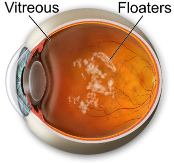Flashes & Floaters
 Floaters often appear as pieces of lint, dust, or debris that float around and are seen best with a blue sky or a slightly off-white wall as the background.
Floaters often appear as pieces of lint, dust, or debris that float around and are seen best with a blue sky or a slightly off-white wall as the background.
Flashes and floaters describe a condition that comes from changes in the back chamber of the eye (the posterior chamber, also known as the vitreous cavity). The posterior chamber is filled with a material called vitreous (the vitreous body) which, at birth, is jelly-like in consistency. With normal aging, the vitreous begins to break down into a mixture of clear liquid and pieces of debris, which appear as specks of dust, lint, lines, branching twigs, or spiders.
Ultimately, the vitreous becomes so loose that it often detaches from its normal attachments to the retina. When this occurs, it is called a posterior vitreous detachment (PVD). After the posterior vitreous detachment has occurred, one will often see a fairly large, ring-like floater. About 15% of people with a posterior vitreous detachment also have an associated retinal tear, which requires medical attention.
Floaters often appear as pieces of lint, dust, or debris that float around and are seen best with a blue sky or a slightly off-white wall as the background.
The flashes of light we see in this normal aging process can be either in the form of lightening bolts, shooting stars, sparks, or an arc of light to the side. The latter is most often what occurs when the vitreous has become so loose that it sloshes around and, when it strikes the retina (the electric membrane of the eye), it sets off an arc of light to the side of vision.
Normally, it is either the vitreous tugging on the retina or bouncing against it that causes the sparks and shooting stars phenomenon. But flashes and floaters may have more serious causes and consequences if the floaters are from blood, inflammatory or infectious processes within the eye, torn retinal tissue, or associated with a retinal detachment. Flashes may also occur with migraine headaches.
Who's At Risk?
Flashes and floaters are very common, most often occurring after the age of 40. Those who are more likely to experience it are those who:
- Are nearsighted.
- Have had cataract surgery.
- Have had a YAG laser surgery of the eye.
- Have had inflammatory disease inside the eye.
- Have had previous injury to the eye (such as being hit by a fist, a ball, etc)
Signs and Symptoms
Although you cannot see floaters or flashes just by looking at the eye, you know you have them when you see:
- Sparks of light.
- Shooting stars of light.
- Lightening-like bolts of light.
- Arcs of light to the side.
- Hair-like, spider-like, or twig-like objects in your line of vision.
The floaters are best seen against a background of a blue sky, a slightly off-white-colored wall, or in the area lit up by car headlights in a dense fog. Notice also that floaters follow you as you look around. So, if you look to the left, the floaters will drift into your left field of vision as well.
Self-Care Guidelines
There is nothing that you can do to prevent the normal aging process that results in flashes and floaters. However, it is extremely critical to be aware of when flashes and/or floaters might be very serious and require medical attention (see below).
Note: The flashes seen with migraines are normally not associated with floaters. Furthermore, migraine headaches produce flashes that are very distinctive, usually last for a set amount of time, and occur the same way each time. You can get migraine types of flashes without any headache (ophthalmic migraine). Finally, it is important to make sure the floaters are not actually debris in the outermost layer of the eye (tear film layer) that simply disappears once you rinse your eyes out or blink several times.
When to Seek Medical Care
What is most critical about flashes and floaters is their timing and course. If you have the sudden onset of flashes and floaters and/or a marked increase in the number of flashes and floaters, it may be a sign of more serious problems, such as a retinal tear or retinal detachment. This requires prompt attention and evaluation by an eye care professional. If you have experienced recent injury to the eye and then notice flashes and/or floaters, you should get a medical evaluation.
Other reasons to seek medical attention for flashes and/or floaters are:
- Vision loss
- Pain
- A curtain or veil that blocks part of your vision and does not move or float
- If you think you have had a posterior vitreous detachment (see above)
Treatments Your Physician May Prescribe
If the flashes and floaters are purely from normal aging, then no treatment is needed. In time, the flashes and floaters will become much less if this is the cause. If, however, there is a retinal tear, bleeding, retinal detachment, or infection inside the eye, medical and surgical therapy will be needed.
Such therapy may include any or all of the following:
- Laser surgery, if a retinal hole or tear is detected
- Surgical repair of a retinal detachment
- Topical eye drops
- Oral medications
Lastly, although you may hear that normal floaters can be removed by doing a vitrectomy (a surgical procedure to remove some vitreous from the eye), it is rarely done, as the risks of surgery outweigh the benefits.

